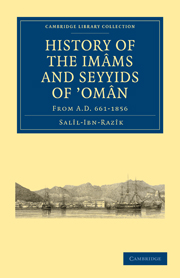Book contents
- Frontmatter
- Contents
- Editor's Preface
- Introduction and Analysis
- Editions of Books quoted by the Editor
- Errata
- List of Imâms, Seyyids, etc., with references to the pages where they are treated of, q.v.
- Author's Title and Preface
- Beginning of the History
- Appendix A On the Title of “Imâm”
- Appendix B The Ibâdhiyah
- Appendix C Murder of the Khalîfah 'Aly-ibn-Abi-Tâlib
- Appendix D Dynasty of the Âl-Bû-Sa'îd
- Postscript: On the Islands of el-Kais and el-Kishm, and the situation of Sîrâf in the Persian Gulf
- Index
Introduction and Analysis
Published online by Cambridge University Press: 07 September 2011
- Frontmatter
- Contents
- Editor's Preface
- Introduction and Analysis
- Editions of Books quoted by the Editor
- Errata
- List of Imâms, Seyyids, etc., with references to the pages where they are treated of, q.v.
- Author's Title and Preface
- Beginning of the History
- Appendix A On the Title of “Imâm”
- Appendix B The Ibâdhiyah
- Appendix C Murder of the Khalîfah 'Aly-ibn-Abi-Tâlib
- Appendix D Dynasty of the Âl-Bû-Sa'îd
- Postscript: On the Islands of el-Kais and el-Kishm, and the situation of Sîrâf in the Persian Gulf
- Index
Summary
Ancient Western geographers afford very slight information respecting 'Oman. Ptolemy's account of the Eastern Coast of Arabia contains little more than a list of names, and his map is meagre and distorted. He mentions a Moscha a portus in latitude 14 deg. N., one degree and a half to the westward of his Syagros extrema, and an Omanutn Emporium in lat. 19 deg. 45 min. These localities are also mentioned by the author of the Periplûs, who says: “Adjoining to Svágros there is a bay which runs deep into the mainland [of] Omana, 600 stadia in width; after which there are high mountainous rocks, steep to and inhabited by a [wild] race that live in caverns and hollows of the cliffs. This appearance of the coast continues for 500 stadia more, at the termination of which lies a harbour called Moscha, much frequented on account of the Sachalitie incense which is imported there.” According to this statement, Suágros was at one end of the bay and Moscha at the other, 1, 100 stadia farther north, or rather north-east, the two places being separated by the mainland of Omana. As the Syagros extrema of Ptolemy and the Suágros of the Periplûs undoubtedly represent the modern Râs-Fàrtak, it is clear that the Moscha of neither can be Maskat, which is at least 480 miles to the north of that cape. There is no port answering to Ptolemy's Moscha where he locates it; but the Moscha of the Periplûs may stand for Bunder-Resût, with which Mr. H. J. Carter identifies it.
- Type
- Chapter
- Information
- History of the Imâms and Seyyids of ‘OmânFrom A.D. 661–1856, pp. xix - cxxPublisher: Cambridge University PressPrint publication year: 2010First published in: 1871

